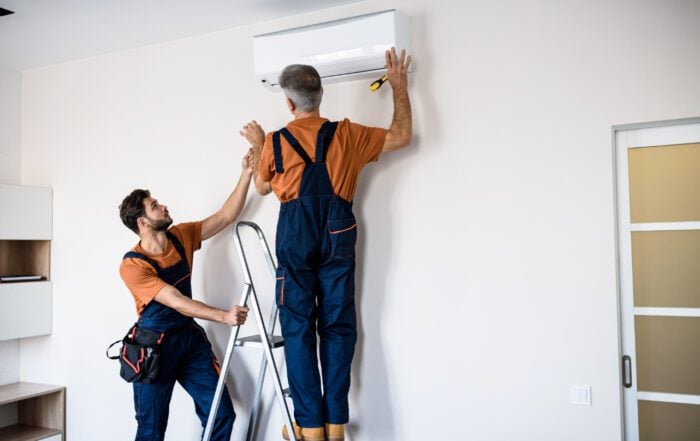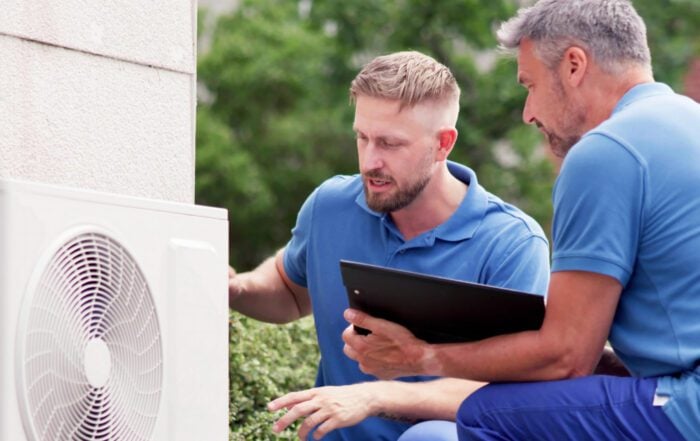This morning you woke up in your comfortable, 72° bedroom, stepped into your slippers or flip flops, and went outside to retrieve today’s newspaper to read with your morning coffee. As you opened the door to the Cleveland sunrise, you subconsciously noticed that this morning is just a little bit cooler than yesterday. You hear a car breeze past your house as someone heads into work for an early shift, and then you catch the hum of your air conditioning unit, wedged between two bushes next to your driveway.
Warm days may still be on the horizon for a bit longer, but we’re past our peak of hot, summer weather for the year here in Ohio – school is back in session, and September and October are just around the corner. So how much longer will that A/C run before you switch over to heat? With the unpredictability of weather near the Lake, it could be sooner than we think. We’re already seeing some signs of the approaching cold season like crisp mornings and changing leaves.
Preparing for the cold season is something that should be taken seriously so we can stay safe and comfortable when the snow starts falling – putting it off too long puts you at risk for not doing it at all. One of the first things we should begin with is winterizing our heating and cooling system.
Winterizing your HVAC and air conditioning units doesn’t have to be a long process, but it’s a process nonetheless.
Winterization is the process of making your heating and cooling system ready for the winter season.
And if any maintenance must be completed, you want to make sure it is scheduled before cold weather sets in.
WHY WINTERIZE?
Winterizing your system ensures that you will be comfortable this winter as well as ready to use your air conditioner right away when the warm weather strikes again. You don’t want to experience an unexpectedly high energy bill when you’re on a budget, or worse: no heat due to something that could easily have been fixed before the cold settles for the season.
It also improves the lifespan of the equipment. If you allow your system to run without general maintenance from time to time, the longevity will decrease, meaning you’ll need to replace costly parts or the system as a whole more often than those who regularly maintain it.
The process of winterizing gives you a reason to clean your registers, outside unit, and replace your filter as well – most of which have probably seen neglect for the better part of the year. Because these aren’t things which typically make our cleaning or honey-do list, it’s natural to forget about them.
So where do you begin? A good place to start is on the inside and work your way out.
WINTERIZING THE HVAC SYSTEM
1. Change your filter.
A new air filter should be priority number one. We cannot stress this enough.
Because filters can go for months without needing to be replaced, they can often be forgotten; and if you leave it in place for too long, you can cause stress on the HVAC system, prompting it to work harder to force air through the blocked filter and driving up your utility costs.
Replacing the filter is one of the easiest and most cost-effective solutions for maintaining your HVAC system. If you are not sure which size to purchase as a replacement, the dimensions should be indicated on the side of the old filter.
It is of particular importance for the colder months when your family will spend more time indoors, too. An air filter is the main line of defense between your family and airborne allergens.
2. Clean your registers.
With doors and window continually being opened and closed and dirt being brought in from the outside all summer long, it’s easy for registers and air returns to have dust and particles build up along the openings. Aside from causing your system to work harder to get air to you, it can force allergens into the air you’re breathing.
Just remove the grill and wipe around the openings as well as the vents themselves. This will allow for better airflow as well cut down on allergens and particles dislodging into the air and being breathed in.
3. Seal any gaps in your heating and cooling vents.
Closing off breaks helps to eliminate drafts which will seep in once the cold weather hits Cleveland. It also prevents the heating system from working too hard to equalize the temperature in the rooms where the vents are located, driving up your energy costs.
WINTERIZING THE AIR CONDITIONING UNIT
1. You’ll want to begin by turning off the power to the outside unit.
There is commonly a panel on the outside of the home with the exterior circuits for the air conditioner which should be readily accessible.
Turning the power off will prevent electrocution or damage to the unit while you’re working to clean it and winterize it for the season. This also prevents accidental use of the air conditioner during the winter.
2. Clean up the outside unit.
Hanging plants or debris can cause damage to the A/C when it’s not in use – winter winds can blow it under the unit, and leaves and twigs can become trapped by drifts of snow. This can cause damage when the system is turned back on in the summer if it’s not rechecked. You’ll also want to be sure to trim back any plants that are growing too close to the air conditioner.
Cleaning the fan blades and condensing coils is also a necessity. Dust and dirt are blown in during use in the summer and can cause slow operation. A pressure washer can make quick work of this project.
3. Check the unit for any damage.
Because the conditioner is left exposed to rain, wind, snow, and extreme temperatures, cracking and rusting often occur over time during operation. If you notice cracks or places that need to be sealed, make sure you contact your HVAC technician before the weather turns.
4. Cover the unit.
There are two schools of thought on how to protect your unit when not in use:
- One is to place a cover over the outdoor air conditioner. These can be relatively inexpensive to purchase, depending on the size of your unit.
To make sure it can breathe during the winter months, make sure you leave a foot (12”) of the coil exposed to keep moisture from getting trapped under the cover and growing mold – this will cause a major health concern when you start it back up next year.
- The other option is to place a board on top of the unit, allowing exposure to all sides for fresh air. This also protects it from any falling debris and ice – a common problem in Northeast Ohio.
However, because the sides are exposed to fresh air, they’re also exposed to snow and ice. Precipitation could get inside the unit without difficulty but should melt and dry out by spring.
5. Check it throughout the winter.
Make sure you mark a few times on your calendar to check on the A/C unit during the winter. Snow and ice can build up, putting pressure on the frame and causing potential damage later down the road, so it should be cleaned off every now and again.
6. If you have any window units, store them for the season.
Do not leave window units in windows during the winter.
This will allow too much cold air to drift in during the season, making your HVAC unit work harder to heat the room – which drives up your energy consumption.
Leaving them mounted will also decrease the longevity of the window unit – it leaves them exposed to elements they’re not designed for and can damage them in the long run.
CALL STACK
If you’re unsure of any step in the winterizing process, or if there is an issue that needs to be resolved by a professional, one of our service technicians will be more than happy to pay you a visit.
Have Any Questions?
If this is an emergency please call 440-937-9134.
Otherwise, please feel free to call us or submit this form to schedule an appointment for service or request an estimate. We will contact you shortly!



